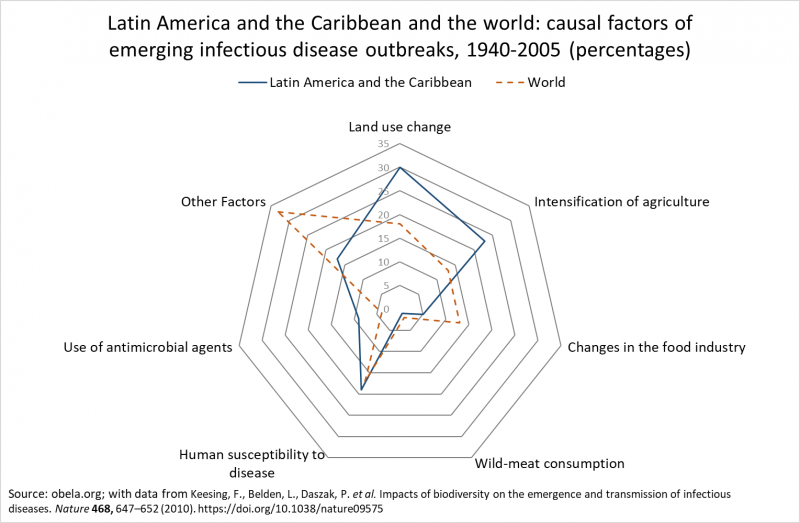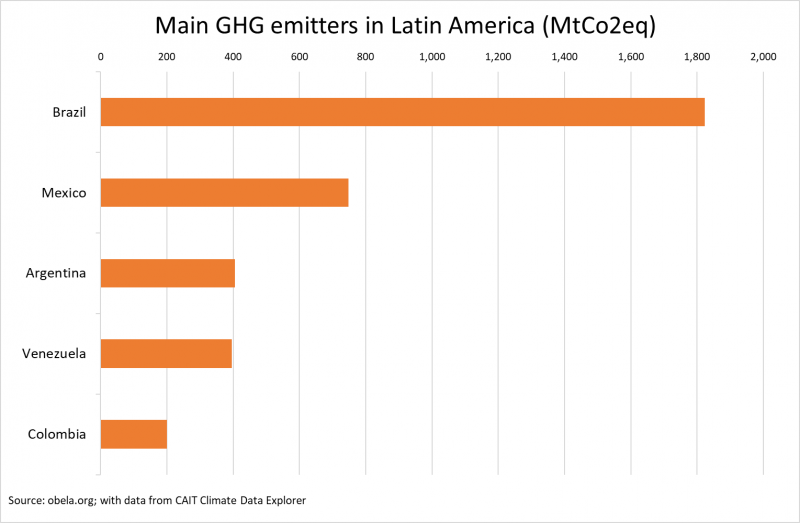The speed and effects of climate change generate a crisis even more serious than the pandemic. The current development path has put at risk the balance of the ecological system that supports it. What is the relationship between the pandemic and the environment?
Due to the growing influence of humans on nature, biogeochemical cycles have been drastically altered and biodiversity reduced at a threatening rate. The causes include rising global temperatures. The objective of the Paris Agreement (2016) by the year 2100 is to keep global average temperature increase below 2°C with respect to pre-industrial levels (1880) and preferably below 1.5°C, otherwise environmental risks will increase dramatically.
The increase in temperature favours the development of infections (Zhou et.al, 2008) and extends the scope of transmission of several zoonoses, which as we see today, are not limited to a single region, but reach the global level. In addition, there is concern about bacteria and viruses that have so far remained frozen in permafrost, as humans would have little immune resistance to them.
The natural barriers between humans and pathogens become more fragile as the natural balance is disturbed and ecosystem resilience, genetic diversity, and microbial resistance and pathogen spread increase (F. Keesing, et al., 2010).
The Latin American and Caribbean region emits less concentration of Greenhouse Gases (GHGs) worldwide, however, it is mostly affected by climate change. The Caribbean is particularly vulnerable because the population lives on islands and its cities are even more exposed due to their proximity to the sea, as they depend on it environmentally and economically. Since not all countries and social groups contribute to emissions and suffer their impact in the same proportion, environmental policy needs to be based on the principle of common but differentiated responsibilities. On a continental level, the United States is the largest emitter of CO2 (399 billion tons).
In Latin America, the main measures being developed to reduce GHG emissions are the implementation of renewable energies, increased energy efficiency, forest protection, improved agricultural practices, adequate waste management and improved industrial processes.

Planetary boundaries define a safe space for science-based sustainable development, in which the risk of dramatic environmental changes remains low. There are currently nine of them that have been possible to identify: climate change, biosphere integrity, biogeochemical flows, land use change, novel entities, stratospheric ozone depletion, atmospheric aerosol loading, ocean acidification and freshwater use. Of these limits, the first four have been exceeded. Environmental policy, the private sector, civil society and the scientific community need to act together on this concept so that they can inform sustainability transformations and pathways to achieve the Agenda 2030 and Paris Agreement goals to reduce pressure on these limits.
In Latin America, the post-pandemic project: Economic Recovery Plan with Social and Environmental Justice 2020-2030 has been presented, promoted by the international movement "Our Green America", led by social and political leaders of the region. It consists of implementing measures for the transition to sustainable energy in housing and transport; as well as the defense of water, social protection for workers and fair financing measures, such as the collection of wealth tax.
Nitrogen dioxide is a harmful gas emitted by engines, power plants and industry. Since February, NASA satellites have detected falls of between 20% and 30% in emissions of this gas in some countries hit hard by economic closure, such as Italy and the United States.

As a consequence of the pandemic, industrial activities were reduced, the number of flights was reduced and massive events were suspended, resulting in positive but temporary impacts such as a reduction in the level of GHG emissions, lower consumption of fossil fuels and improvement in air quality. In some countries, society is beginning to develop an environmental awareness and long-term plan and initiatives in favour of the environment have already begun to be seen, which could lead to demands being made on the State and industries to rethink the structure of the economy and production and thus to adapt and limit themselves to the natural cycles of the environment to allow for its regeneration.
The report published in November by the European Environment Agency (EEA) states that in addition to the positive effects, there have also been negative consequences such as the increased use of single-use plastics and the increased generation of household and hospital waste.
The pandemic brings to the table the complex interaction between the systems of planet Earth and the current structure of social, economic and environmental policies.









